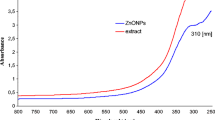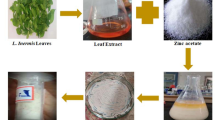Abstract
The problem of microbial resistance is growing, and search for novel approaches to tackle the problem on multidrug resistance pathogens is the need of the hour. The present investigation involves green synthesis of zinc oxide nanoparticles (ZnO NPs) using Cassia auriculata leaf extract and evaluates its synergistic antimicrobial and cytotoxic effect. The results of various techniques confirmed the formation of ZnO NPs. UV-visible spectrum of ZnO NPs showed maximum peak at 370 nm. The crystalline nature of the ZnO NPs was confirmed by XRD analysis. The SEM analysis revealed that particles were spherical and irregular in shape, and average size of nanoparticles was 68.64 nm. The antimicrobial activity and synergistic antimicrobial activity were evaluated against pathogenic microorganisms. ZnO NPs showed broad spectrum of antimicrobial activity against tested pathogens and enhanced synergistic antimicrobial activity as compared to standard antibiotic. Cytotoxic effect of ZnO NPs was evaluated by MTT assay against HeLa cancer cell line, and ZnO NPs showed dose-dependent cytotoxic activity. The synthesized ZnO NPs possess significant antimicrobial and cytotoxic activity and hence can be used therapeutically as nanomedicine for diagnosis and drug therapy.






Similar content being viewed by others
References
West, J. L., & Halas, N. J. (2000). Applications of nanotechnology to biotechnology: commentary. Current Opinion in Biotechnology, 11(2), 215–217.
Mason, C., Vivekanandha, S., Misra, M., & Mohanty, A. K. (2012). Switch grass (Panicum virgatum) extract medicated green synthesis of silver nanoparticles. World Journal of Nano Science and Engineering, 2, 47–52.
Devi, R. S., & Gayathri, R. (2014). Green synthesis of zinc oxide nanoparticles by using Hibiscus rosa-sinensis. International Journal of Current Engineering and Technology, 4(4), 2444–2446.
Wang, Z. L. (2004). Zinc oxide nanostructures: growth, properties and applications. Journal of Physics: Condensed Matter, 16(25), 829–858.
Malaikozhundan, B., Vaseeharan, B., Vijayakumar, S., Pandiselvi, K., Kalanjiam, M. A. R., Murugan, K., & Benelli, G. (2017). Biological therapeutics of Pongamia pinnata coated zinc oxide nanoparticles against clinically important pathogenic bacteria, fungi and MCF-7 breast cancer cells. Microbial Pathogenesis, 104, 268–277.
Salari, Z., Ameri, A., Forootanfar, H., Adeli-Sardou, M., Jafari, M., Mehrabani, M., & Shakibaie, M. (2017). Microwave-assisted biosynthesis of zinc nanoparticles and their cytotoxic and antioxidant activity. Journal of Trace Elements in Medicine and Biology, 39, 116–123.
Suresh, D., Nethravathi, P. C., Udayabhanu, R. H., Nagabhushana, H., & Sharma, S. C. (2015). Green synthesis of multifunctional zinc oxide (ZnO) nanoparticles using Cassia fistula plant extract and their photodegradative, antioxidant and antibacterial activities. Materials Science in Semiconductor Processing, 31, 446–454.
Azizi, S., Mohamad, R., & Shahri, M. (2017). Green microwave-assisted combustion synthesis of zinc oxide nanoparticles with Citrullus colocynthis (L.) Schrad: characterization and biomedical applications. Molecules. https://doi.org/10.3390/molecules22020301.
Madan, H. R., Sharma, S. C., Udayabhanu, S. D., Vidya, Y. S., Nagabhushana, H., Rajanaik, H., Anantharaju, K. S., Prashantha, S. C., & Maiya, P. S. (2016). Facile green fabrication of nanostructure ZnO plates, bullets, flower, prismatic tip, closed pine cone: their antibacterial, antioxidant, photoluminescent and photocatalytic properties. Spectrochimica Acta Part A: Molecular and Biomolecular Spectroscopy, 152, 404–416.
Kumar, R. S., Ponmozhi, M., Viswanathan, P., & Nalini, N. (2002). Effect of Cassia auriculata leaf extract on lipids in rats with alcoholic liver injury. Asia Pacific Journal of Clinical Nutrition, 11(2), 157–163.
Chanda, S., Kaneria, M., & Baravalia, Y. (2012). Antioxidant and antimicrobial properties of various polar solvent extracts of stem and leaves of four Cassia species. African Journal of Biotechnology, 11(10), 2490–2503.
Muthu, K., & Priya, S. (2017). Green synthesis, characterization and catalytic activity of silver nanoparticles using Cassia auriculata flower extract separated fraction. Spectrochimica Acta Part A: Molecular and Biomolecular Spectroscopy, 179, 66–72.
Padalia, H., & Chanda, S. (2017). Characterization, antifungal and cytotoxic evaluation of green synthesized zinc oxide nanoparticles using Ziziphus nummularia leaf extract. Artificial Cells, Nanomedicine Biotechnology. https://doi.org/10.1080/21691401.2017.1282868.
Padalia, H., Baluja, S., & Chanda, S. (2017). Effect of pH on size and antibacterial activity of Salvadora oleoides leaf extract-mediated synthesis of zinc oxide nanoparticles. BioNanoScience, 7(1), 40–49.
Perez, C., Paul, M., & Bazerque, P. (1990). An antibiotic assay by the agar well diffusion method. Acta Biologiae et Medicine Experimentalis, 15, 113–115.
Rakholiya, K., & Chanda, S. (2012). In vitro interaction of certain antimicrobial agents in combinations with plant extracts against some pathogenic bacterial strains. Asian Pacific Journal of Tropical Biomedicine, 2(2), 876–880.
Gajhiye, M., Kesharwani, J., Ingle, A., Gade, A., & Rai, M. (2009). Fungus-mediated synthesis of silver nanoparticles and their activity against pathogenic fungi in combination with fluconazole. Nanomedicine: Nanotechnology, Biology, and Medicine, 5, 382–386.
Labieniec, M., & Gabryelak, T. (2003). Effects of tannins on Chinese hamster cell line B14. Mutation Research/Genetic Toxicology and Environmental Mutagenesis, 539(1–2), 127–135.
Moteriya, P., & Chanda, S. (2016). Synthesis and characterization of silver nanoparticles using Caesalpinia pulcherrima flower extract and assessment of their in vitro antimicrobial, antioxidant, cytotoxic, and genotoxic activities. Artificial Cells, Nanomedicine, and Biotechnology. https://doi.org/10.1080/21691401.2016.1261871.
Vijayakumar, S., Vinoj, G., Malaikozhundan, B., Shanthi, S., & Vaseeharan, B. (2015). Plectranthus amboinicus leaf extract mediated synthesis of zinc oxide nanoparticles and its control of methicillin resistant Staphylococcus aureus biofilm and blood sucking mosquito larvae. Spectrochim. Acta Part A: Molecular Biomolecular Spectroscopy, 137, 886–891.
Ramesh, M., Anbuvannan, M., & Viruthagiri, G. (2015). Green synthesis of ZnO nanoparticles using Solanum nigrum leaf extract and their antibacterial activity. Spectrochimica Acta Part A: Molecular and Biomolecular Spectroscopy, 136, 864–870.
Awwad, A. M., Albiss, B., & Ahmad, A. L. (2014). Green synthesis, characterization and optical properties of zinc oxide nanosheets using Olea europea leaf extract. Advanced Materials Letters, 5(9), 520–524.
Nagajyothi, P. C., Cha, S. J., Yang, I. J., Sreekanth, T. V. M., Kim, K. J., & Shin, H. M. (2015). Antioxidant and anti-inflammatory activities of zinc oxide nanoparticles synthesized using Polygala tenuifolia root extract. Journal of Photochemistry and Photobiology B: Biology, 146, 10–17.
Nair, M. G., Nirmala, M., Rekha, K., & Anukaliani, A. (2011). Structural, optical, photo catalytic and antibacterial activity of ZnO and Co doped ZnO nanoparticles. Materials Letters, 65(12), 1797–1800.
Rao, V. S., Ramana, M. V., Satish, N. N., Anuradha, G., & Nageswari, B. (2013). Bio fabrication and characterization of zinc nanorods from Aloe vera. International Journal of Science and Research, 148–150.
Elumalai, K., & Velmurugan, S. (2015). Green synthesis, characterization and antimicrobial activities of zinc oxide nanoparticles from the leaf extract of Azadirachta indica (L.) Applied Surface Science, 345, 329–336.
Raj, F. A. A., & Jayalakshmy, E. (2015). Effect of zinc oxide nanoparticle produce by Zingiber officinale against pathogenic bacterial. Journal of Chemical and Pharmaceutical Sciences, 8(1), 124–127.
Janaki, A. C., Sailatha, E., & Gunasekaran, S. (2015). Synthesis, characteristics and antimicrobial activity of ZnO nanoparticles. Spectrochimica Acta Part A: Molecular and Biomolecular Spectroscopy, 144, 17–22.
Brayner, R., Iliou, R. F., Brivois, N., Djediat, S., Benedetti, M. F., & Fievet, F. (2006). Toxicological impact studies based on Escherichia coli bacteria in ultrafine ZnO nanoparticles colloidal medium. Nano Letters, 6(4), 866–870.
Baek, Y. W., & An, Y. J. (2011). Microbial toxicity of metal oxide nanoparticles (CuO, NiO, ZnO and Sb2 O3) to Escherichia coli, Bacillus subtilis and Streptococcus aureus. Science of the Total Environment, 409(8), 1603–1608.
Sharma, S. C. (2016). ZnO nano-flowers from Carica papaya milk: degradation of Alizarin Red-S dye and antibacterial activity against Pseudomonas aeruginosa and Staphylococcus aureus. Optik, 127, 6498–6512.
Jayaseelan, C., Rahuman, A. A., Kirthi, A. V., Marimuthu, S., Santhoshkumar, T., Bagavan, A., Gaurav, K., Karthik, L., & Rao, K. V. B. (2012). Novel microbial route to synthesize ZnO nanoparticles using Aeromonas hydrophila and their activity against pathogenic bacteria and fungi. Spectrochimica Acta Part A: Molecular and Biomolecular Spectroscopy, 90, 78–84.
Banoee, M., Seif, S., Nazari, Z. E., Jafari-Fesharaki, P., Shahverdi, H. R., Moballegh, A., Moghaddam, K. M., & Shahverdi, A. R. (2010). ZnO nanoparticles enhanced antibacterial activity of ciprofloxacin against Staphylococcus aureus and Escherichia coli. Journal of Biomedical Materials Research Part B: Applied Biomaterials, 93(2), 557–561.
Dobrucka, R., & Dugaszewska, J. (2015). Biosynthesis and antibacterial activity of ZnO nanoparticles using Trifolium pratense flower extract. Saudi Journal of Biological Sciences, 23(4), 517–523.
Fayaz, A. M., Balaji, K., Girilal, M., Yadav, R., Kalaichelvan, P. T., & Venketesan, R. (2010). Biogenic synthesis of silver nanoparticles and their synergistic effect with antibiotics: a study against Gram positive and Gram negative bacteria. Nanomedicine: Nanotechnology, Biology and Medicine, 6(1), 103–109.
AbdEIhady, M. M. (2012). Preparation and characterization of chitosan/zinc oxide nanoparticles for imparting antimicrobial and UV protection to cotton fabric. International Journal of Carbohydrate Chemistry. https://doi.org/10.1155/2012/840591.
Sharma, N., Jandaik, S., & Kumar, S. (2016). Synergistic activity of doped zinc oxide nanoparticles with antibiotics: ciprofloxacin, ampicillin, fluconazole and amphotericin B against pathogenic microorganisms. Anais da Academia Brasileira de Ciências, 88(3), 1689–1698.
Fu, G., Vary, P. S., & Lin, C. T. (2005). Anatase TiO2 nanocomposites for antimicrobial coatings. The Journal of Physical Chemistry B, 109(18), 8889–8898.
Yamamoto, O. (2001). Influence of particle size on the antimicrobial activity of zinc oxide. International Journal of Inorganic Materials, 3(7), 643–646.
Ann, L. C., Mahmud, S., Bakhori, S. K. M., Sirelkhatim, A., Mohamad, D., Hasan, H., Seeni, A., & Rahman, R. A. (2014). Antibacterial response of zinc oxide structures against Staphylococcus aureus, Psuedomonas aeruginosa and Streptococcus pyogenes. Ceramics International, 40(2), 2993–3001.
Chung, I. I. I.-M., Rahuman, A. A., Marimuthu, S., Kirthi, A. V., Anbarasan, K., & Rajakumar, G. (2015). An investigation of the cytotoxicity and caspase-mediated apoptotic effect of green synthesized zinc oxide nanoparticles using Eclipta prostrata on human liver carcinoma cells. Nanomaterials, 5(3), 1317–1330.
George, S., Pokhrel, S., Xia, T., Gilbert, B., Ji, Z., Schowalter, M., Rosenauer, A., Damoiseaux, R., Bradley, K. A., Mädler, L., & Nel, A. E. (2010). Use of a rapid cytotoxicity screening approach to engineer a safer zinc oxide nanoparticle through iron doping. ACS Nano, 4(1), 15–29.
Acknowledgements
The authors thank the Department of Biosciences (UGC-CAS) for providing excellent research facilities. Ms. Hemali Padalia is thankful to UGC-CAS, and Ms. Pooja Moteriya is thankful to UGC, New Delhi, India, for providing Junior Research Fellowship.
Author information
Authors and Affiliations
Corresponding author
Ethics declarations
Conflict of Interest
The authors declare that they have no conflict of interest.
Rights and permissions
About this article
Cite this article
Padalia, H., Moteriya, P. & Chanda, S. Synergistic Antimicrobial and Cytotoxic Potential of Zinc Oxide Nanoparticles Synthesized Using Cassia auriculata Leaf Extract. BioNanoSci. 8, 196–206 (2018). https://doi.org/10.1007/s12668-017-0463-6
Published:
Issue Date:
DOI: https://doi.org/10.1007/s12668-017-0463-6




